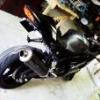Fishing around through some Japanese catalogues recently, I came across something really interesting in the Tomei book, factory cam specs for every performance Nissan built from 1984 to 2003.
So what? Surely there isn’t anything interesting about standard camshafts? On the contrary, they teach you a lot about how engines have been designed and improved between models. Sometimes you can also find an alternative factory cam that will be an improvement over your existing cams.
An important difference that crops up between models is the type of lash adjustment used. That is, the method used to maintain the right clearance between the cam lobe and the valve actuation device. In most cases, a hydraulic lifter or rocker post is used to create a maintenance free system. While good in theory, these systems sometimes run into problems with high revving engines using high lift cams, where the hydraulic system stops working as it should. The hydraulic lifter can pump up which has been known to cause broken rocker arms and worse.
The other approach is a solid system, where the clearance is adjusted using shims. Naturally, this means more maintenance, as when the shims wear you need to replace them to stop the valve train rattling. Also, if you fit new cams, you will have to machine or replace the shims to suit. The advantage is that the simplicity of the system avoids problems associated with hydraulic systems, making them good for high revving engines with high lift cams.
Most cams’ profiles are listed with the duration in degrees, then the lift in millimetres (mm). When cam centre angle is mentioned, this is a measurement that indicates the overlap of the cams. For example, non turbo FJ20 inlet cams have an angle of only 99°, which is considered quite aggressive for a factory cam and gives quite a lumpy idle, whereas the inlet cam on an R33 RB25DE is 120°, which means less overlap and the very smooth idle we expect from these engines. Adjustable cam gears on a twin cam engine allow you to alter these figures yourself.
FJ20
Both the turbo and non turbo versions of this engine in the DR20 Skyline have 256° inlet and exhaust cams, with 8.85mm lift on both cams. The only difference was the centre angle of the inlet cam being more aggressive on the NA version
The relatively long cam duration explains why FJ20’s have such a lumpy idle. The can centre angles are also very aggressive compared to later Nissan performance engines. Solid lifters and a chain instead of a timing belt contribute to the noisiness of the FJ20 head, but also make it very good for racing applications.
Aftermarket cams run as much as 10.35mm lift without needing any head modifications. The only catch is that adjustable cam sprockets are time consuming to adjust, as they use offset holes rather than a slider system, and the whole cam cover has to be removed and replaced every time you try a new setting.
CA18
Both the turbo and the non turbo versions of the CA18 have 240°/7.8mm inlet and 248°/8.5mm exhaust cams, the only difference being a more aggressive exhaust cam angle on the NA version. Some tuners have found gains by fitting the NA exhaust cam to the turbo engine.
The lash adjustment in this head design limits lift to 8.8mm on aftermarket cams, unless you convert to a solid system, in which case anything up to 10.25mm is available from Tomei. The CA uses a timing belt, with a separate cover making cam adjustment very easy. Adjustable pulleys look very similar to RB types, but have a different offset, so they aren’t interchangeable.
SR20
The cams in the S14 and S15 Silvia engines are identical. In the NA versions, the inlet cam is 248°/10.0mm and the exhaust cam 240°/9.20mm. The turbo inlet cam is different, matching the exhaust cam at 240°/9.20mm, with a slightly more aggressive cam angle.
The S13 version (before the NVCS inlet cam timing adjuster was added) had the same cam specs on the turbo, but with different centre angles. The NA version had a longer duration exhaust cam than the later versions at 246V but the same lift (9.2mm), again with totally different cam centre angles on both cams. Looking at this, there may be some advantage to using the NA type inlet cam in any given turbo version of the SR20, but only testing would tell, and in any case, there is only a tiny difference in spec.
Interestingly Nissan went back to a chain for the cam timing in the SR, but a larger cam sprocket design means slider adjustable sprockets are available. Unfortunately, you still have to take the whole cam cover off to make an adjustment.
The NA version of the SR used in FWD cars such as the Pulsar SSS and Primera actually had less duration and lift than the Silvias and no NVCS. As such, it would be worthwhile to fit the S13 NA cams into these engines. Most had only 240°/9.4mm inlet and 232°/8.5mm exhaust cams.
The odd one out in the SR20 turbo range is the RNN14 (Pulsar GTI-R) engine, which had solid lifters and more aggressive cams than any other turbo SR engine. The profiles were 248°/10.0mm on both inlet and exhaust, with no NVCS system.
The most interesting SR20 of all is the SR20VE used in the top of the line P11 and P12 Primeras. This was an entirely revised head design, featuring Nissan’s Neo VVL (Variable Valve Lift) cams. Much like Honda’s VTEC, this system uses two different cam profiles for different rpm ranges.
The P11 version used a 22°/8.4mm inlet and 220°/6.6mm exhaust cam at low revs, giving a very smooth idle. The second cam profile was very aggressive, with 264°/10.7mm inlet and 268°/10.34mm exhaust. Combined with 11:1 compression, these NA engines made 190ps (140kW) at 7000rpm, compared to 140ps (103kW) at 6400rpm for a normal SR20DE of the same year.
The P12 version was more aggressive again, using 228°/10.10mm inlet and 244°/8.30mm low rpm cams, with 278°/12.0mm inlet and 280°/11.15mm exhaust profiles. These are amazing figures for what is still a hydraulic lash adjuster system.
This head can be fitted to the older turbo engines, but some sort of control module would be needed to make the VVL system work. The engines are also very expensive, as you might expect. Nissan also made an SR16VE, which had the same head and 86mm bore size, but only 68.7mm stroke. The engine revved to 8000rpm and made 175ps at 7800rpm.
RB20
All RB engines have hydraulic lifters and quite low lift figures. The NICS type RB20 turbo (R31) had 248°/7.8mm inlet and 240°7.8mm exhaust cams. In the ECCS type RB20 turbo (R32) they went to 240°/7.8mm on both cams.
Strangely, the NA version in the R32 had even milder inlet cams at 232°/7.3mm. Much like the CA18, you can’t run more than 8.8mm lift with an aftermarket cam, unless you change to a solid lifter, which would allow up to 10.25mm from Tomei.
RB25
The first version of the RB25 was an NA engine used in the R32 Gts25. This had 240°/7.8mm inlet and 232°/7.3mm exhaust cams and hydraulic lifters, so it’s not very interesting, except that it was the only version of the RB25 without the NVCS can timing system.
The R33 used 240°/7.8mm inlet and exhaust cams on both the turbo and NA versions, again with hydraulic lifters and the NVCS system altering inlet cam timing.
The R34 version changed to solid lifters, allowing higher lift, which helped the power output. The specs were 236°/8.4mm inlet and 232°/8.7mm exhaust on the turbo version, while the NA version only had 6.9mm lift on the exhaust cam. The NVCS system was also changed on the R34, operating up the 5400rpm on the turbo, compared to 4500 for the R33.
RB26
All RB26 engines have solid lifters and the same cam profiles, being 240°/8.58mm inlet and 236°/8.28mm exhaust. The only difference between the different models is the centre angles. R32 and R33 are the same except for the R33 N1, which had a more aggressive exhaust cam centre angle. The R34 also had a more aggressive exhaust cam centre angle, but a less aggressive inlet cam.
It is possible to run as much as 11.8mm lift in an Rb26, but for more than 9.5mm, the head has to be modified to allow sufficient clearance and upgraded springs should be used for anything over 8.8mm.
VG30
In the Z32 300ZX, the turbo and NA cams are the same, being 248°/8.5mm for inlet and exhaust, with hydraulic lifters and the NVCS system. Again, 8.8mm is the most lift you can use without changing to solid lifters, which allows up to 10.25mm from Tomei.
VQ35
The all new alloy 350Z engine uses solid lifters and relatively high lift cams. The standard specs are 238°/9.2mm inlet and 240°/9.2mm exhaust. The NVCS system can alter inlet timing from 125° to 90° and operates over the entire rev range. No doubt aftermarket cams have already appeared.

Nissan Cam Spam
Started by 2LV8ETR, Feb 24 2011 11:01 PM
#1

 Posted 24 February 2011 - 11:01 PM
Posted 24 February 2011 - 11:01 PM

#2

 Posted 26 February 2011 - 08:41 PM
Posted 26 February 2011 - 08:41 PM

Very Intamaresting...

Go Hard Or Fuck Off Home. Kick Ass, Take No Prisoners!!!
All donations to West Coast Cruisers is very much appreciated
#3

 Posted 27 February 2011 - 04:33 PM
Posted 27 February 2011 - 04:33 PM

Yeah man, this is what I was speaking to you about a couple of weeks ago. I finally found the time to write it up it on the forum. It's a bit long winded but covers most of the better Nissan engines.

#4

 Posted 28 February 2011 - 05:35 PM
Posted 28 February 2011 - 05:35 PM

#5

 Posted 28 February 2011 - 07:38 PM
Posted 28 February 2011 - 07:38 PM

#6

 Posted 01 March 2011 - 06:25 PM
Posted 01 March 2011 - 06:25 PM

#7

 Posted 01 March 2011 - 08:45 PM
Posted 01 March 2011 - 08:45 PM

i read 2 lines and fell asleep
Always remember that I have taken more out of alcohol than alcohol has taken out of me. An alcoholic is someone you don't like who drinks as much as you do. Don't drink and drive, you might hit a bump and spill your drink. You're not drunk if you can lie on the floor without holding on. Stay busy, get plenty of exercise, and don't drink too much. Then again, don't drink too little. Time is never wasted when you're wasted all the time. One reason I don't drink is that I want to know when I am having a good time. A meal without wine is like a day without sunshine, except that on a day without sunshine you can still get drunk. I stopped drinking, but only when I sleep. This is one of the disadvantages of wine: it makes a man mistake words for thought. Cigarettes and coffee: an alcoholic's best friend !!!! When I read about the evils of drinking, I gave up reading. I hate to advocate drugs, alcohol, violence, or insanity to anyone, but they always worked for me. The consumption of alcohol may cause pregnancy. A man who exposes himself when he is intoxicated, has not the art of getting drunk. A bartender is just a pharmacist with a limited inventory. I drink to forget I drink. Alcohol is necessary for a man so that he can have a good opinion of himself, undisturbed be the facts. Once, during Prohibition, I was forced to live for days on nothing but food and water. The whole world is about three drinks behind. I love cooking with wine. Sometimes I even put it in the food.
#8

 Posted 01 March 2011 - 09:01 PM
Posted 01 March 2011 - 09:01 PM

#9

 Posted 01 March 2011 - 09:43 PM
Posted 01 March 2011 - 09:43 PM

#10

 Posted 16 March 2011 - 01:35 AM
Posted 16 March 2011 - 01:35 AM

hey allen
if i gave you a cam, could you work out it's lift and durations/all of it specs for me?
money will be involved if needed.
if i gave you a cam, could you work out it's lift and durations/all of it specs for me?
money will be involved if needed.

 Sign In
Sign In Create Account
Create Account

 Back to top
Back to top












